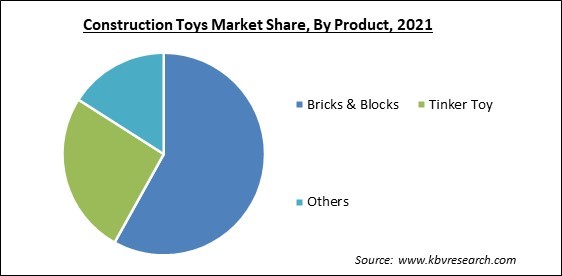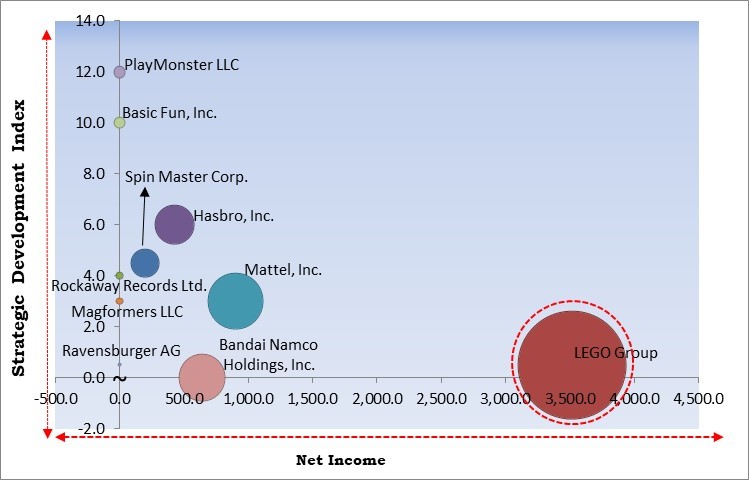The Global Construction Toys Market size is expected to reach $18.1 billion by 2028, rising at a market growth of 6.5% CAGR during the forecast period.
Manufacturers of construction toys promote plastics as being fully safe for children because of their low degree of toxicity and water resistance. Toys with PVC, plasticizers, and Bisphenol A, which includes adipates and phthalates as ingredients, should not be given to children since they may have detrimental effects on their health and stunt their development. The use of these materials in toys has been outlawed in numerous nations, including Germany, Sweden, and India. Toy producers are being compelled to avoid the aforementioned plastic materials due to growing awareness among parents and educational authorities.

The market is anticipated to expand more quickly as the advantages of construction toys for children's cognitive development become more widely acknowledged. The demand from educational systems is expected to be driven by the goods' ability to help youngsters develop their spatial reasoning. For instance, early education classes feature toys made of bricks and blocks. These activities for kindergarteners are intended to promote holistic development by encouraging children's imagination and inventiveness.
Construction toys have repeatedly been highlighted as having a positive impact on children's cognitive flexibility in recent research studies on child psychology and cognitive development. These games encourage creative problem-solving. Children are challenged to come up with original solutions while assembling parts to recreate a specific structure, which is essential for their cognitive development. Additionally, playing these games might enhance cooperation, social skills, and teamwork abilities.
The economy was severely impacted by the coronavirus outbreak that spread across the world. Lockdowns have been ordered in many nations around the world in an effort to stop the chain and spread of the coronavirus. The supply chains, avenues of distribution, trade, and growth of the building toy business were all severely harmed by this. Additionally, since the COVID-19 pandemic, the selling of toys on various e-commerce websites has increased, which could increase the need for additional building toys over the projection period.
Children are becoming addicted to TVs, computers, and mobile phones, so parents are seeking ways to get them involved in new physical activities. With the aid of construction toys, kids may exercise their bodies and minds while also developing their inventiveness and social abilities. Building blocks, model construction vehicles, and city-building toys are just a few of the cutting-edge construction toys that vendors are offering to children.
Companies are concentrating on forming alliances with various marketing firms and well-known social media influencers for creating content for youngsters in order to promote a strong brand image. This aids them in increasing their gaming-related earnings. Additionally, the rising demand for toys in several colors among preschoolers is projected to drive market expansion.
The introduction and spread of e-commerce helped to increase the sales of counterfeit items by expanding their geographic reach. Additionally, these items cause market fragmentation, a lack of price uniformity, a decline in the margins of branded competitors, a decline in the brand value of significant competitors, an unfavorable competitive environment, and the loss of market share. Disney toys and Mattel toys are two of the most often imitated brands on the market.

On the basis of material, the construction toys market is fragmented into wood, polymer, metal and others. The wood segment covered a substantial revenue share in the construction toys market in 2021. As a result of being non-toxic and safe for children, wooden toys are predicted to expand in popularity and drive market expansion. Due to the material's longevity, these products can last for generations, which is expected to be positive for the segment's growth.
Based on product, the construction toys market is segmented into bricks & blocks, tinker toys and others. The tinker toys segment acquired a substantial revenue share in the construction toys market in 2021. This expansion is being accelerated by the increased difficulty and appeal of the toys as well as their ability to provide a wider range of creations. The use of parts like caps, wheels, sticks, pulleys, and couplings in the tinker toys encourages children's imagination and critical thinking.
By distribution channel, the construction toys market is classified into hypermarkets & supermarkets, specialty stores, online and others. In 2021, the hypermarkets & supermarkets segment witnessed the highest revenue share in the construction toys market. Better visibility of consumer goods products has been made possible by the organized retail sector's framework, and growth is anticipated to be boosted by the products' accessibility and immediate availability.
| Report Attribute | Details |
|---|---|
| Market size value in 2021 | USD 11.8 Billion |
| Market size forecast in 2028 | USD 18.1 Billion |
| Base Year | 2021 |
| Historical Period | 2018 to 2020 |
| Forecast Period | 2022 to 2028 |
| Revenue Growth Rate | CAGR of 6.5% from 2022 to 2028 |
| Number of Pages | 211 |
| Number of Tables | 375 |
| Report coverage | Market Trends, Revenue Estimation and Forecast, Segmentation Analysis, Regional and Country Breakdown, Competitive Landscape, Companies Strategic Developments, Company Profiling |
| Segments covered | Product, Distribution Channel, Material, Region |
| Country scope | US, Canada, Mexico, Germany, UK, France, Russia, Spain, Italy, China, Japan, India, South Korea, Singapore, Malaysia, Brazil, Argentina, UAE, Saudi Arabia, South Africa, Nigeria |
| Growth Drivers |
|
| Restraints |
|
Region wise, the construction toys market is analyzed across North America, Europe, Asia Pacific and LAMEA. In 2021, the North America segment led the construction toys market with the largest revenue share. This is because of the growing use of blocks and construction sets in kindergartens in the United States and Canada. Construction toys are used by academics and child psychologists from a number of American colleges to study children's cognitive abilities.
Free Valuable Insights: Global Construction Toys Market to reach USD 18.1 Billion by 2028

The major strategies followed by the market participants are Acquisitions. Based on the Analysis presented in the Cardinal matrix; LEGO Group is the major forerunner in the Construction Toys Market. Companies such as Basic Fun, Inc., PlayMonster LLC and Hasbro, Inc. are some of the key innovators in Construction Toys Market.
The market research report covers the analysis of key stake holders of the market. Key companies profiled in the report include Hasbro, Inc., Mattel, Inc., Spin Master Corp., LEGO Group (KIRKBI A/S), Ravensburger AG, Magformers LLC, PlayMonster LLC, Bandai Namco Holdings, Inc., Rockaway Records Ltd., Basic Fun, Inc.
By Material
By Product
By Distribution Channel
By Geography
The global Construction Toys Market size is expected to reach $18.1 billion by 2028.
Parents Are Paying More Attention to Children's Overall Development are driving the market in coming years, however, Availability of Alternative Products restraints the growth of the market.
Hasbro, Inc., Mattel, Inc., Spin Master Corp., LEGO Group (KIRKBI A/S), Ravensburger AG, Magformers LLC, PlayMonster LLC, Bandai Namco Holdings, Inc., Rockaway Records Ltd., Basic Fun, Inc.
The Bricks & Blocks market has acquired maximum revenue in the Global Construction Toys Market by Product in 2021; thereby, achieving a market value of $10.3 billion by 2028.
The Polymer market is leading the Global Construction Toys Market by Material in 2021; thereby, achieving a market value of $7.0 billion by 2028.
The North America market dominated the Global Construction Toys Market by Region in 2021; thereby, achieving a market value of $6.3 billion by 2028.
Our team of dedicated experts can provide you with attractive expansion opportunities for your business.

